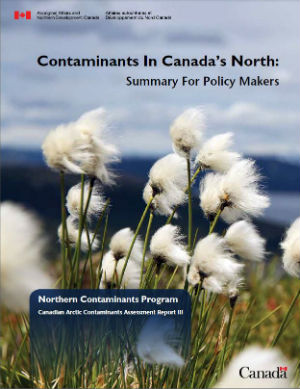Full Report (PDF)
Key Findings
KEY FINDING #1:
Concentrations of `legacy POPs´ are generally going down across the Arctic.
KEY FINDING #2:
As `new POPs´ come under regulation, their levels in the Arctic decline.
KEY FINDING #3:
Mercury levels in the Arctic are stabilizing but are still several times higher than during pre-industrial times.
KEY FINDING #4:
Climate change can affect how POPs and mercury cycle in the Arctic environment and accumulate in wildlife.
KEY FINDING #5:
The complex movement of contaminants in the Arctic environment and wildlife is now better understood.
KEY FINDING #6:
Current levels of POPs and mercury may be a risk for the health of some Arctic wildlife species.
KEY FINDING #7:
While exposure to most POPs and mercury is generally decreasing among Northerners, mercury remains a concern in some regions.
KEY FINDING #8:
Traditional/country foods continue to be important for maintaining a healthy diet for Northerners.
KEY FINDING #9:
Environmental exposure to contaminants in the Arctic has been linked to health effects in people.
KEY FINDING #10:
Continued international action is vital to reducing contaminant levels in the Arctic.
Future Directions
Contaminants from long-range, global sources continue to be of concern in Canada’s North. These contaminants accumulate in animals that serve as foods traditionally consumed by Northerners and impact on the health and well-being of both wildlife and people. While much progress has been made in Canada and internationally to address the issue of some POPs and mercury, the problem has not been solved, particularly as many new POPs appear in the Arctic environment, and as climate and other changes (e.g. increased economic development in In light of the findings of the CACAR III assessments, the NCP also calls for broader action on measures related to achieving its mandate and supporting Arctic science in general:
Canadian research and monitoring programs, including the NCP, must work together to:
- ensure long-term monitoring networks have the resources they need to continue to be operational into the future.
- ensure that northern data are properly archived, managed and made available in an open, transparent, and timely manner, e.g. through the Polar Data Catalogue, and research results are communicated in timely and culturally appropriate ways.
- ensure that programs are complementary, with results feeding into one another in a way that enables multidisciplinary assessments of crosscutting issues, such as climate change.
- engage and empower northern communities, organizations and governments to lead and fully participate in Arctic research through capacity building initiatives, support for community-based research and shared decision-making.
- engage in international networks and multinational monitoring and research initiatives, to the greatest extent possible, in order to address the circumpolar and global scientific challenges presented by climate change and contaminants.
Arctic Nations, including Canada must:
- communicate national POPs data and information promptly to Arctic Council/AMAP and Stockholm Convention’s Global Monitoring Plan and POPs Review Committee to ensure maximum global impact.
- be encouraged to swiftly ratify the Minamata Convention, so that it may enter into force as soon as possible, leading to a reduction in mercury entering into Arctic ecosystems.
- ensure that the issue of food (and water) security, which includes the safety of traditional/country foods, is recognized by Northern policy makers in Canada and by the Arctic Council as a priority for action.
- monitor the impacts of socio-economic and environmental changes in the Arctic on local sources of contaminants to assess their potential influence on overall exposures in the Arctic.
- consider the impacts of contaminants on ecosystems and people in the development of adaptation strategies for a changing Arctic.

